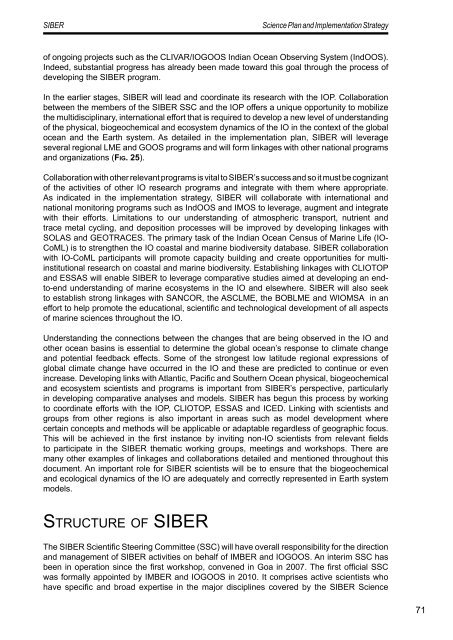SIBER SPIS sept 2011.pdf - IMBER
SIBER SPIS sept 2011.pdf - IMBER
SIBER SPIS sept 2011.pdf - IMBER
You also want an ePaper? Increase the reach of your titles
YUMPU automatically turns print PDFs into web optimized ePapers that Google loves.
<strong>SIBER</strong><br />
Science Plan and Implementation Strategy<br />
of ongoing projects such as the CLIVAR/IOGOOS Indian Ocean Observing System (IndOOS).<br />
Indeed, substantial progress has already been made toward this goal through the process of<br />
developing the <strong>SIBER</strong> program.<br />
In the earlier stages, <strong>SIBER</strong> will lead and coordinate its research with the IOP. Collaboration<br />
between the members of the <strong>SIBER</strong> SSC and the IOP offers a unique opportunity to mobilize<br />
the multidisciplinary, international effort that is required to develop a new level of understanding<br />
of the physical, biogeochemical and ecosystem dynamics of the IO in the context of the global<br />
ocean and the Earth system. As detailed in the implementation plan, <strong>SIBER</strong> will leverage<br />
several regional LME and GOOS programs and will form linkages with other national programs<br />
and organizations (Fig. 25).<br />
Collaboration with other relevant programs is vital to <strong>SIBER</strong>’s success and so it must be cognizant<br />
of the activities of other IO research programs and integrate with them where appropriate.<br />
As indicated in the implementation strategy, <strong>SIBER</strong> will collaborate with international and<br />
national monitoring programs such as IndOOS and IMOS to leverage, augment and integrate<br />
with their efforts. Limitations to our understanding of atmospheric transport, nutrient and<br />
trace metal cycling, and deposition processes will be improved by developing linkages with<br />
SOLAS and GEOTRACES. The primary task of the Indian Ocean Census of Marine Life (IO-<br />
CoML) is to strengthen the IO coastal and marine biodiversity database. <strong>SIBER</strong> collaboration<br />
with IO-CoML participants will promote capacity building and create opportunities for multiinstitutional<br />
research on coastal and marine biodiversity. Establishing linkages with CLIOTOP<br />
and ESSAS will enable <strong>SIBER</strong> to leverage comparative studies aimed at developing an endto-end<br />
understanding of marine ecosystems in the IO and elsewhere. <strong>SIBER</strong> will also seek<br />
to establish strong linkages with SANCOR, the ASCLME, the BOBLME and WIOMSA in an<br />
effort to help promote the educational, scientific and technological development of all aspects<br />
of marine sciences throughout the IO.<br />
Understanding the connections between the changes that are being observed in the IO and<br />
other ocean basins is essential to determine the global ocean’s response to climate change<br />
and potential feedback effects. Some of the strongest low latitude regional expressions of<br />
global climate change have occurred in the IO and these are predicted to continue or even<br />
increase. Developing links with Atlantic, Pacific and Southern Ocean physical, biogeochemical<br />
and ecosystem scientists and programs is important from <strong>SIBER</strong>’s perspective, particularly<br />
in developing comparative analyses and models. <strong>SIBER</strong> has begun this process by working<br />
to coordinate efforts with the IOP, CLIOTOP, ESSAS and ICED. Linking with scientists and<br />
groups from other regions is also important in areas such as model development where<br />
certain concepts and methods will be applicable or adaptable regardless of geographic focus.<br />
This will be achieved in the first instance by inviting non-IO scientists from relevant fields<br />
to participate in the <strong>SIBER</strong> thematic working groups, meetings and workshops. There are<br />
many other examples of linkages and collaborations detailed and mentioned throughout this<br />
document. An important role for <strong>SIBER</strong> scientists will be to ensure that the biogeochemical<br />
and ecological dynamics of the IO are adequately and correctly represented in Earth system<br />
models.<br />
St r u c t u r e o f <strong>SIBER</strong><br />
The <strong>SIBER</strong> Scientific Steering Committee (SSC) will have overall responsibility for the direction<br />
and management of <strong>SIBER</strong> activities on behalf of <strong>IMBER</strong> and IOGOOS. An interim SSC has<br />
been in operation since the first workshop, convened in Goa in 2007. The first official SSC<br />
was formally appointed by <strong>IMBER</strong> and IOGOOS in 2010. It comprises active scientists who<br />
have specific and broad expertise in the major disciplines covered by the <strong>SIBER</strong> Science<br />
71












